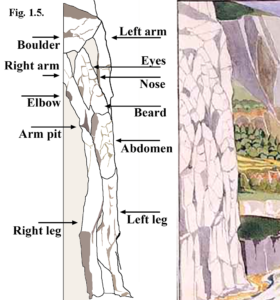RIVENDELL: STONE-GIANT
Tolkien hides another image on the far left cliff in the picture which is cunningly hidden by the maze of rocks around it (fig. 1.5 below). The right outline of the giant forms the right edge of the cliff. To the giant’s left are more rocks. It’s two arms raised above its head hold a boulder.
The presence of this image here in Rivendell perhaps requires explanation because the stone-giants don’t appear in  the Rivendell narrative. Tolkien is linking this valley to the valley in the Misty Mountains scene in which the stone giants appear published as “The Mountain-path” in the first impression of Hobbit in 1937. (Pictures 7). Tolkien’s painting of the Rivendell valley unquestionably reproduces the likeness of the Lauterbrunnen in Switzerland, which he hiked through in 1911, “We went on foot carrying great packs practically all the way from Interlaken, mainly by mountain paths, to Lauterbrunnen”(Letters 551, #306). He described this experience as leaving “many vivid pictures as clear as yesterday”(Letters 551, #306). And we can assuredly connect Rivendell with the valley of the falling boulders thrown by the giants via the rock falls that Tolkien experienced in Switzerland near the Aletsch glacier. Speaking of his aunt:
the Rivendell narrative. Tolkien is linking this valley to the valley in the Misty Mountains scene in which the stone giants appear published as “The Mountain-path” in the first impression of Hobbit in 1937. (Pictures 7). Tolkien’s painting of the Rivendell valley unquestionably reproduces the likeness of the Lauterbrunnen in Switzerland, which he hiked through in 1911, “We went on foot carrying great packs practically all the way from Interlaken, mainly by mountain paths, to Lauterbrunnen”(Letters 551, #306). He described this experience as leaving “many vivid pictures as clear as yesterday”(Letters 551, #306). And we can assuredly connect Rivendell with the valley of the falling boulders thrown by the giants via the rock falls that Tolkien experienced in Switzerland near the Aletsch glacier. Speaking of his aunt:
“It was in her company (with a mixed party of about the same size as the company in The Hobbit) that I journeyed on foot with a heavy pack through much of Switzerland, and over many high passes. It was approaching the Aletsch that we were nearly destroyed by boulders loosened in the sun rolling down a snow-slope. An enormous rock in fact passed between me and the next in front. That and the ‘thunder-battle’ – a bad night in which we lost our way and slept in a cattle-shed – appear in The Hobbit” (Letters 439, #232).
During the “thunder-battle” the allusion to the Lauterbrunnen valley is clear:
“Boulders, too, at times came galloping down the mountain-sides, let loose by midday sun upon the snow, and passed among them (which was lucky), or over their heads (which was alarming). The nights were comfortless and chill, and they did not dare to sing or talk too loud, for the echoes were uncanny, and the silence seemed to dislike being broken-except by the noise of water and the wail of wind and the crack of stone.
“The summer is getting on down below,” thought Bilbo, “and haymaking is going on and picnics” (Hobbit 4.53-54).
In this way he links the stone-giant valley with the midsummer Rivendell valley. This and the other landslide on the eastern side of the Misty Mountains represent the “real-life” boulder fall he experienced. In Alvíssmol Thor is described as “Thor the Hurler”. In the “thunder-battle” we read: “When he peeped out in the lightning-flashes, he saw that across the valley the stone-giants were out and were hurling rocks at one another for a game” (54-55). In Rivendell Bilbo and Gandalf are both on the other side of the valley to the hidden giant.
Tolkien links the hidden imagery in Rivendell to the valley where the stone-giants fight in other ways too. The Lauterbrunnen is famous for its many hanging valleys. In the valley of the stone-giants we find: “There they were sheltering under a hanging rock for the night” (54) and “Then came a wind and a rain, and the wind whipped the rain and the hail about in every direction, so that an overhanging rock was no protection at all” (55). We’ve already seen the great overhanging boughs like the brim of Gandalf’s hat. The hanging valleys of the Lauterbrunnen are above the cliff face where his hat is,—they feed the many waterfalls into the Lauterbrunnen. Gandalf and Thorin serve as “no protection” against the stone-giants. This is a good example of creating meaning via word repetition across links. This and his argument with Thorin explain his frowning brows in his hidden image. Gandalf is Odin and his image is suspended in the cliff, his hat his brows are the overhanging cliff. Odin has many names pertaining to hanging and gallows: “Gallows‘ Burden”, “Lord of the hanged”, “Hanged One“, “Ruler of Gallows“, “Dangler”. “Dangle” is to ““hang loosely, […] suspended““. Given this, we might also understand the giant to be hanging from the rock above his head.